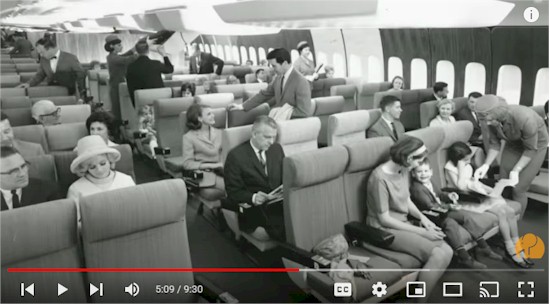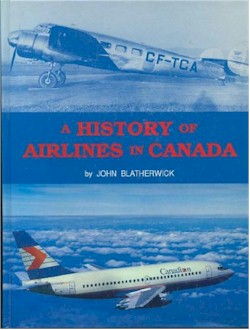|
|
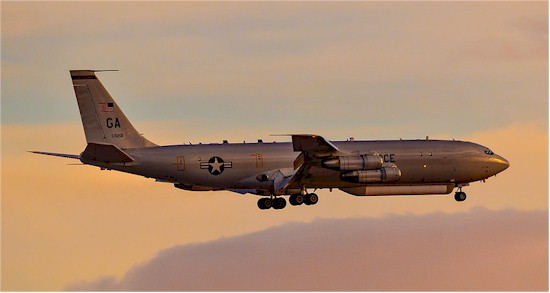 |
|
Former RCAF registration 13704, USAF 97-0201 |
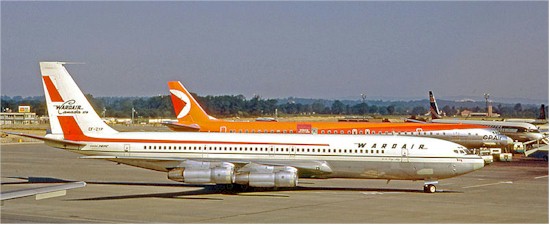 |
|
Wardair Canada Boeing 707 CF-ZYP at London Gatwick in 1970 |
|
Regarding our article on Great Lakes Airlines in NetLetter #1487, subscriber Doug Keller brought to our attention a book entitled 'A History of Airlines in Canada' written by Dr. John Blatherwick. Doug sent us an excerpt from the book relating to Great Lakes Airlines. However, due to copyright, we are not able to publish an excerpt without express permission. We were able to contact Dr. Blatherwick via email and he, very graciously, has given us his permission. We wish to thank Dr. Blatherwick and his publisher, The United Press, for allowing us to print and link to the following excerpt. Also, thanks to Doug Keller for bringing it to our attention. Click the book cover below if you may be interested in purchasing a copy. Editors' Note: We would be remiss not to mention that being an author is only one part of Dr. Blatherwick's distinguished career. He served in the Canadian Forces reserves for 39 years, retiring in 2000 with the rank of Commander and the position of Senior Naval Reserve Medical Advisor. He also served as the Medical Health Officer or Chief Medical Health Officer in Vancouver, British Columbia from 1984 to 2007. He became a member of the Order of Canada on May 3, 1995. |
|
DC-3's were purchased in 1967 to supplement the company's Cessna 310 and tri-gear Beech 18 as it began a scheduled service between Sarnia and Toronto. Two Convair 440 aircraft were bought in 1969 from Swissair. Called the Metropolitan, the piston twin engine Convair 440 carried forty-four passengers and bore a colour scheme with a broad red cheat line running through the windows of the white aircraft. The upper three quarters of the tail was red and displayed a white map of the Great Lakes within a white circle. Once the Convairs arrived, the Beech 18 was sold to Air Windsor and the two DC-3's sold to Pem-Air of Pembroke. When London, Ontario, was added to the Sarnia to Toronto route in 1973, four more Convair 440s were purchased from Linjeflyg of Sweden. These white aircraft had a broad blue cheat line above a thin white cheat line and a thin dark blue cheat line below both and had an all-white tail. One of a variety of symbols was found on the tail, including a map of the Great Lakes in blue but with no circle, a stylized 'GLA' or no symbol at all. With the additional aircraft, Peterborough, Ottawa and Kitchener were added to flights from Toronto. |
|
|
|
PERX.com brought to you by Interline Vacations. |
|
September 3, 2022 - 8 night Caribbean September 17, 2022 - 10 night Mediterranean October 8, 2022 - 5 night Bermuda Call 1-888-737-9266 for more details and many other offerings. |
|
Continuation of the Air Canada nee Trans-Canada Air Lines History started in NetLetter #1483. Source: Air Canada 75 years of innovation
More to follow in future NetLetters |
|
On April 1, 2021 Air Canada celebrated the 70th anniversary of its Montreal–Paris route. Air Canada is marking its 70th anniversary on its Montreal – Paris route, a route that has never been suspended, not even for the pandemic. On April 1, 1951, a four-engine, 40-passenger Canadair North Star, registered as CF-TFO and operated by Trans-Canada Air Lines (now Air Canada), touched down for the very first time at Orly airport, in the suburbs of Paris. Initially entailing a layover in London, UK, the flight between Montreal and Paris quickly became a non-stop, weekly service after its initial success. Source: www.travelweek.ca |
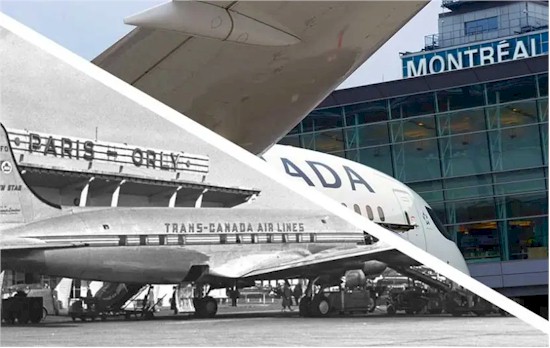 |
 |
|
The history of Rise Air is intimately connected to the growth of the Canadian aviation industry and the development of the Northern Saskatchewan region. Formed in 2021 when Transwest Air and West Wind Aviation combined operations under one brand, Rise Air has built on the legacies of these two airlines and is now one of the largest independent air carriers in Canada with the most diverse and comprehensive fleet of fixed-wing aircraft in Saskatchewan with specialized charters and the largest scheduled service network in Saskatchewan. Source: riseair.ca |
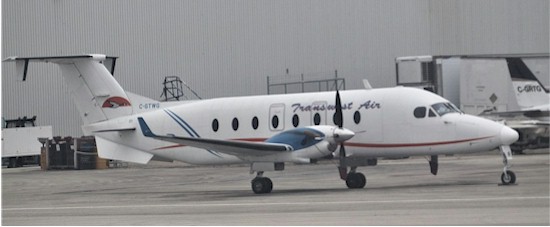 |
| Transwest Air Beechcraft 1900D |
|
In Alaska, Door Dash, Grub Hub and Uber Eats orders come in a Cessna, Beaver or Otter for some customers. According to The New York Times, the popular urban services, which exploded in popularity during the pandemic, have given Alaskans in remote areas the opportunity for a taste of “city food” from time to time to break the tedium of the fare stored or hunted by many far-flung residents. Aircraft are the only way to supply many of the wilderness communities in winter and everything from pizza to chow mein are now a common part of the shipments of more basic necessities. Customers pay from $10 to $30 for their day-old dinners. The service is so popular that Alaska Air Transit set up a tent in the parking lot at the airport where the delivery drivers drop off and label the orders with the names and villages of the recipients. Source: AVWeb.com |
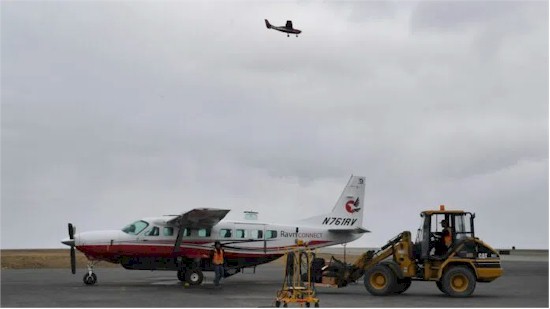 |
|
World's fastest passenger jet goes supersonic in tests. The race to resume supersonic passenger flights nearly two decades after the retirement of Concorde was offered a glimmer of excitement on Monday when plane manufacturer Bombardier revealed high speed achievements while confirming the launch of its new business jet. The Canadian company said the in-development Global 8000 will be “the world’s fastest and longest-range purpose-built business jet.” With a capacity for up to 19 passengers, a range of 8,000 nautical miles (14,800 kilometers) and a top speed of Mach 0.94, the upcoming plane is expected to enter service in 2025, according to a statement from Bombardier. The news comes after a Global 7500 test vehicle broke the sound barrier during a demonstration flight last May, achieving speeds of more than Mach 1.015. Source: CNN Travel |
 |


